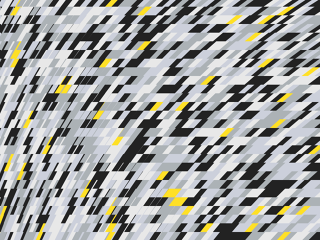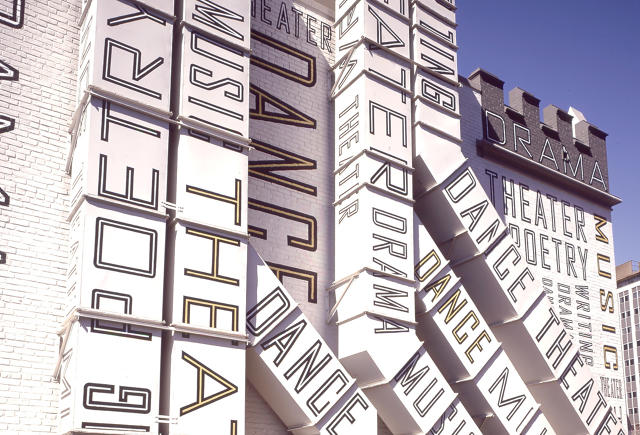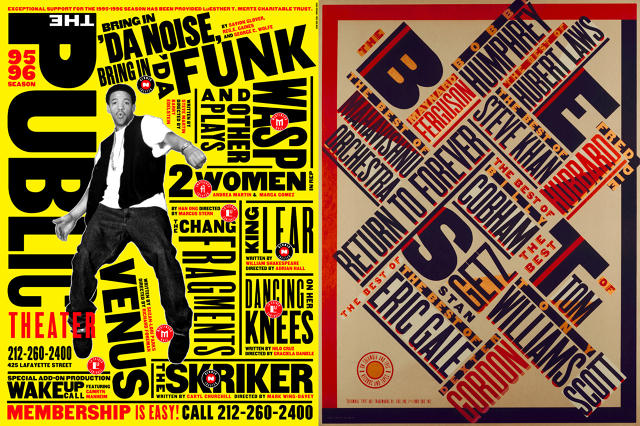Scher discusses her worst jobs, her biggest challenge as a designer, and her productivity secret (embrace boredom!).
Late last month, Pentagram partner  Paula Scher released her elaborate, if controversial, new identity for the New School. The branding is centered around an algorithm-based typeface, in which each letterform comes in three distinct widths, letting words be printed in an endless variety of permutations—a scheme variously described as “unique,” “edgy,” and a “typographical trainwreck.” Scher, whose design career spans four decades with work like identities for MoMA, the Public Theater, and the Metropolitan Opera, is used to a little drama. We caught up with the AIGA Medalist about her least favorite types of design jobs, her productivity tips (embrace boredom!) and how her mind works “like a slot machine.”
Paula Scher released her elaborate, if controversial, new identity for the New School. The branding is centered around an algorithm-based typeface, in which each letterform comes in three distinct widths, letting words be printed in an endless variety of permutations—a scheme variously described as “unique,” “edgy,” and a “typographical trainwreck.” Scher, whose design career spans four decades with work like identities for MoMA, the Public Theater, and the Metropolitan Opera, is used to a little drama. We caught up with the AIGA Medalist about her least favorite types of design jobs, her productivity tips (embrace boredom!) and how her mind works “like a slot machine.”
What was the first thing you ever designed?
As a kid, I didn’t know what design was. I wanted to be an artist. I drew and painted a lot, and designed publicity posters for my high school, for proms and stuff. I don’t have any copies of that stuff. But it was my claim to fame in high school, probably my greatest success. I consider the first thing I fully designed a children’s book I wrote called The Brownstone. It’s about to be reprinted by Princeton Architectural Press, illustrated by Stan Mack.
What is your biggest challenge as a designer?
Not to repeat. I’ve been designing for over 40 years now, so the question becomes how to approach something with a new point of view. How am I not jaded?

Do you have any productivity tricks?
I have a productivity trick that I didn’t know I had until I heard about it on a radio program. NPR did this interview with experts about boredom. iPhones and other forms of digital media were disrupting boredom, because people can occupy themselves all the time. You don’t have any more downtime—you go on your iPhone, look at email, or you’re playing video games. The fact of the matter is, that eats up really good creative time. I realize that when I’m sitting in a taxicab in traffic, or on my way to the airport, or waiting to get on a plane, or trapped in some other boring situation, that’s when I get the best ideas, because I’ve got nothing else interfering with it. I didn’t realize until I listened to that broadcast how important boredom is to me. I have to stop reading emails or being anywhere near the internet to be able to create.
If I’m alone, I try really hard to shut down, because that’s when I’ll figure out a whole pile of stuff. I’m very disorganized. I never finish sketchbooks—my sketches are on crappy little pieces of paper distributed amongst my team. I’m not like my Pentagram friend Michael Bierut, who has every sketch he’s ever done in his life. The idea for me is find these moments of supreme focus where I gather the shreds of things I’ve thought of independently in moments of boredom or downtime and pushed them through. That seems to be my method.

Do you have an example of a design you thought of while, say, in a taxicab? How does your thought process usually work?
Oh, I think I figured out every identity program I’ve ever done in a taxicab. I really do.
I think your mind is like a giant slot machine. On one side of your brain, you have all the experiences of your life: every influence, everything that ever inspired you, everything that’s ever made you angry, everything you’ve ever thought, just rolling around in there. It’s fodder. On the other side of your brain is where you input a specific brief, and the specific brief has all the constraints and needs of the particular situation. It all sort of rolls around like a slot machine. You want the brief to line up with a perfect piece of fodder. You pull that fodder to make analogies and make points. It may be something that’s stylistic, or may be a pointed reference of some sort, and these things come together and solve the problem. Now, how does the machine work? How do you know it’s going to work? You don’t. That’s why some work is better than others. I remember a book jacket director in the ‘80s who said my work for him wasn’t up to my normal level, and I said, ‘Well, some days I’m just not as talented as other days.’
What’s your favorite thing you own?
My dog! He’s an Australian shepherd, my fourth one. Their names have all started with M—Matty, Mickey, Molly, and Mimi.
My favorite inanimate object: I’ve had the Le Corbusier chaise lounge for about 35 years. I’ve had all other kinds of furniture in combination with it and I could never let that go. I just love it. It’s too stupid.
What is the worst job you’ve ever taken, and what did it teach you?
I don’t have one worst job, I have many. They all seemed like the worst at the time. The most recent one, which was only about three weeks ago, feels as strong as any of the other bad ones, but they all follow the same pattern. The pattern of the worst job is something that I don’t really have interest in designing in the first place. Usually, it’s something I don’t perceive as having a broader value than the moment. They’re things like annual reports or real estate brochures. No one cares about the annual report from the year before. There’s no historic value in it. For a real estate brochure, you’re looking at an apartment, and once you live in the apartment, it’s just a thing of history, so there’s no continuity in that either.
These projects are usually promotional in the worst possible way, because a lot of political or financial chaos is hanging against them. They usually are things that are needed quickly and with intense involvement, and demands from a demanding client. The client is usually nasty when you first meet them, and will continue to be nasty throughout the entire project. You usually get into these projects because you think it’s not going to be so bad, that maybe you’re doing something good, and that you’re going to make money. But no matter how much money you make, it’s never enough, because it’s so incredibly painful and disgusting.
If you weren’t a designer, what would you be, and why?
I don’t think I’d be anything else. I don’t know how to do anything else. I’m completely unemployable.
Everything I do is about making stuff. I paint, I teach, I write, I make large painted maps. But I couldn’t be a full-time painter because it’s too solitary for me. I’m much more social than that.
I’m always surprised when I meet young people who don’t know what they want to do. I never had that problem. I didn’t know what graphic design was when I went to college. I found out that it existed and had natural empathy toward it. But always was gonna be an artist of some sort.

What do you think the biggest challenge facing the world that design can help solve?
There are so many things that involve design. Virtually everything, if you think about it. I’ve been involved in the public sign commission in New York City, and everything from the smallest curb to making judgments about neighborhoods and buildings and parks involves design. For me, that was spectacular. If you take that approach and attach it to the whole world, there’s really everything, isn’t there?
I think the contribution and goal of design is really to raise the expectation of what the design could be. So if you’re thinking about a curb and have a prescribed notion of what a curb is, there might be a better solution. If you’re drawing water in an an environment that doesn’t have a good methodology for doing it, there may be a better one that one can conceive of that solves the problem. That’s the goal. If it’s designing a website for a bank, there can be the easiest one to use that hasn’t been designed yet. All those things are the goal.
What’s your favorite breakfast food?
If I could eat whatever I wanted, I’d eat huevos rancheros. But I usually eat yogurt and fruit, and then I’m hungry by 11.
See the slide show above for a selection of Scher’s best work.
[All Images: Paula Scher/Pentagram]
Fast Company , Read Full Story
(295)